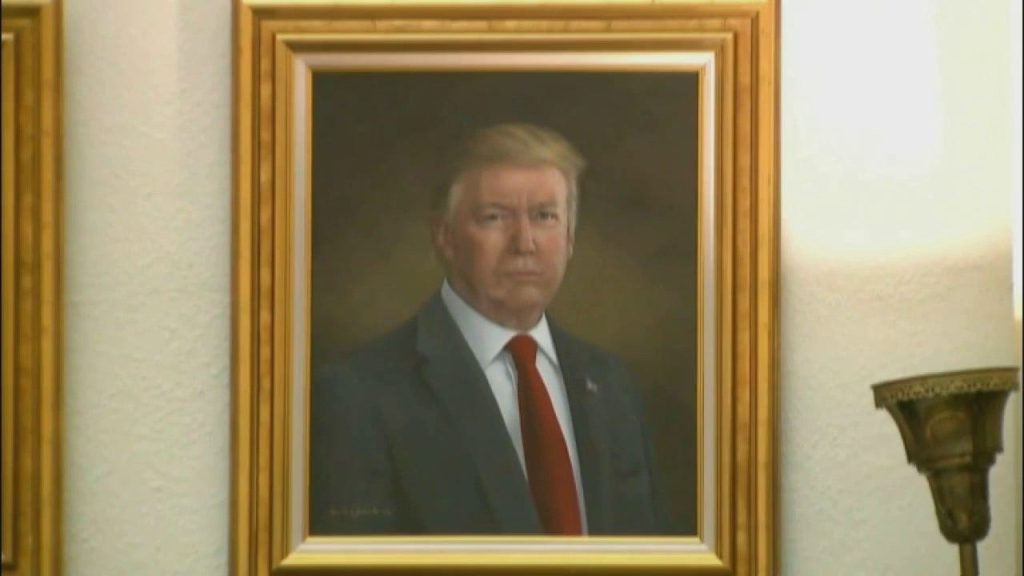In recent developments, former President Donald Trump has publicly expressed his discontent regarding a portrait of himself located in the Colorado State Capitol. He described the artwork as “distorted” and voiced his requests for its removal, asserting that it has drawn complaints from Coloradans. This statement was made via his social media platform, with Trump highlighting a perceived disparity in how he is portrayed compared to other presidents, including Barack Obama.
| Article Subheadings |
|---|
| 1) Trump’s Demand for Removal |
| 2) Public Reactions and Complaints |
| 3) The Artist’s Perspective |
| 4) Political Context and Criticism |
| 5) Future Implications and Ongoing Discourse |
Trump’s Demand for Removal
On a recent evening, former President Donald Trump took to his Truth Social account to voice his dissatisfaction with a portrait of himself that was created for the Colorado State Capitol. He specifically called out the state’s Governor, Jared Polis, demanding the immediate removal of what he termed a “distorted” representation. Trump lamented, “Nobody likes a bad picture or painting of themselves,” indicating that the portrayal did not accurately reflect his appearance. His critique included claims that the likeness he was given was the worst he had ever encountered, contrasting it sharply with the favorable depiction of former President Barack Obama in the same Capitol setting.
Public Reactions and Complaints
Trump’s grievance seems to resonate with a segment of the Colorado populace. He stated that many residents contacted him directly, expressing their disappointment and outrage over his portrait. “In fact, they are actually angry about it!” Trump remarked, suggesting that the artwork has become a point of contention among Coloradans. This portrayal has not merely been an aesthetic disappointment for Trump; it has evolved into a political talking point, with Trump positioning himself as an advocate for public opinion against perceived injustices in coronavirus-related narratives and political representation.
The Artist’s Perspective
The portrait was created by Sarah A. Boardman, an artist who aimed to present a neutral representation of Trump during its unveiling in 2019. Boardman stated her intention was to make a “thoughtful, non-confrontational” portrait that would stand the test of time. At the time of the unveiling, she mentioned that her creative approach was intended to depict Trump in a way that would become part of the historical background rather than evoke strong emotional responses—be it anger or joy. This perspective raised questions about artistic freedom and the implications of political sentiment on artists’ work.
Political Context and Criticism
Along with his comments on the portrait, Trump has used this incident to critique Governor Polis, calling him “extremely weak on crime.” He amplified this narrative by referencing a local crime incident tied to a notorious gang, the Tren de Aragua, suggesting that his leadership and response to crime issues leave much to be desired. Trump’s remarks during this discourse reflect a larger strategy where he connects the image of leadership to the prevailing social issues in Colorado, which he claims are being mishandled, indirectly using the portrait controversy as a platform to engage in broader political discussions.
Future Implications and Ongoing Discourse
As Trump continues to gain traction with his criticisms of Colorado’s governance, it is anticipated that the discourse surrounding the portrait will fuel further media coverage and public discussion. The narrative exemplifies how symbolic representations can elicit strong reactions, shaping not just personal perceptions but also the broader political landscape. Conversations about imagery, representation, and the impact of social media in shaping public opinion stand to grow in prominence, making this controversial portrait more than just art in a government building; it becomes a lens through which to view ongoing political dynamics.
Key Points
| No. | Key Points |
|---|---|
| 1 | Trump demands the removal of a “distorted” portrait from the Colorado State Capitol. |
| 2 | The public response indicates that some Coloradans are upset about the portrait. |
| 3 | Artist Sarah A. Boardman aimed for a neutral representation of Trump. |
| 4 | Trump uses the portrait issue to critique Governor Jared Polis’s crime policies. |
| 5 | The portrait controversy fuels ongoing political discourse surrounding leadership and representation. |
Summary
The ongoing debate over Donald Trump’s portrait at the Colorado State Capitol serves as a compelling case study of the intersection between art, politics, and public sentiment. It highlights how visual representation can evoke strong emotional reactions and become a focal point for broader political conversations. The incident not only sheds light on Trump’s larger narrative about governance and crime but also emphasizes the potency of public opinion in shaping political dialogue.
Frequently Asked Questions
Question: Why did Trump demand the removal of the portrait?
Trump claimed the portrait was “distorted” and did not accurately represent him, leading to complaints from Coloradans.
Question: Who is the artist behind the portrait?
The portrait was created by artist Sarah A. Boardman, who intended to depict Trump in a neutral manner.
Question: How has this incident affected Trump’s relationship with Colorado residents?
The incident has sparked public discourse and revealed a segment of the Colorado population that shares Trump’s dissatisfaction with his portrayal, potentially impacting future political interactions.


